[/caption]
The first Orion crew capsule is rapidly taking shape as assembly work to construct the skeletal framework of the first pathfinder Orion capsule – the Ground Test Article – or GTA, is nearing completion.
The Lockheed Martin team building Orion is just one weld away from completing the framework of an Orion cabin at NASA’s Michoud Assembly Facility in New Orleans. Precision welding to join together the final large skeletal segments (see my earlier report) has proceeded well according to Lockheed managers I spoke with.
“The Orion capsule is the Congressionally approved program of record and we are moving forward with it”, says Larry Price, Lockheed’s Orion Deputy Program Manager in an interview with me. “Our work is continuing with the funding which is still approved until September 2010. Orion is a very functional vehicle. All subsystems will be state of the art.
“Orion is not Apollo on Steroids”, Price emphasized.
“We are building on what is known and it’s a very contemporary approach. The flight avionics are very similar to commercial airliners. We can take advantage of the latest advances in avionics and computing. Orion has been designed for long duration interplanetary functionality to operate beyond Low Earth Orbit (LEO) for 6 months or more to visit the Moon, Asteroids, Lagrange points and other targets of interest for scientific investigation”, Price explained.
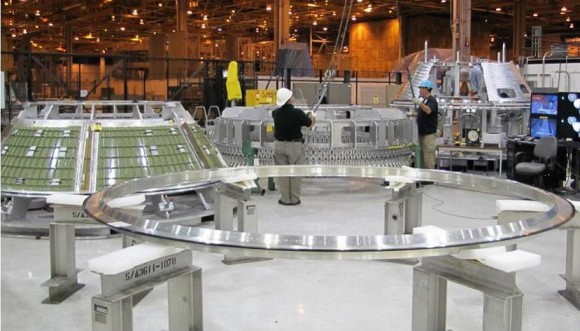
“The Orion project status is we have just one more weld remaining on the crew cabin”, says Tim Knowles. He is the Orion GTA Vehicle manager for Lockheed Martin and discussed Orion development in an interview with me. “When all follow on work to prepare the GTA is done, the final Orion GTA crew cabin will look very much like a real Orion capsule,” Knowles said.
“The final close out weld will join the Forward Cone Assembly and Crew Tunnel to the barrel shaped Aft Assembly. This combined piece then comprises the habitable volume and forms the first structural framework for the first Orion Crew Cabin”.
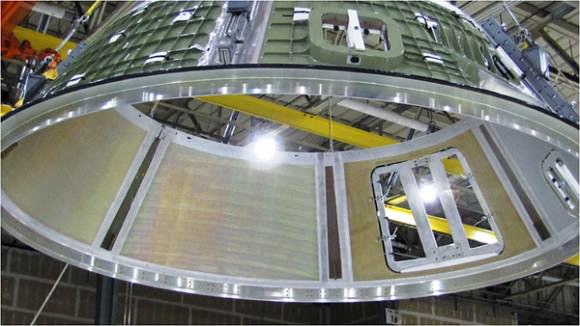
“The welding process uses a technique called Friction Stir Welding (FSW)”, Knowles said. “It has produced acceptable results so far. It’s a learning process and not flawless, and improves each time we do it” added Knowles.
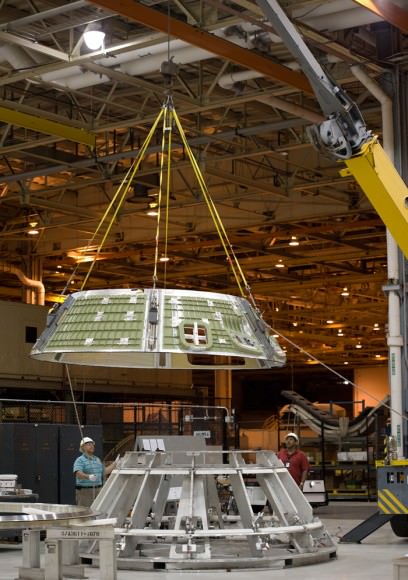
“We use sound to evaluate the work and detect any flaws”, explained Knowles. “The testing method is called Phased Array Ultrasonic Testing (PAUT). It’s a Non-Destruction Evaluation (NDE) technique. Remember, the GTA is intended as a manufacturing pathfinder as well as a structural test article”.
“The actual welding times to combine the individual segments requires only about 45 minutes to an hour. Of course the real trick to getting a good weld is that it takes many many days of preparation work to get the parts and equipment and everything else set up properly,” explained Knowles.
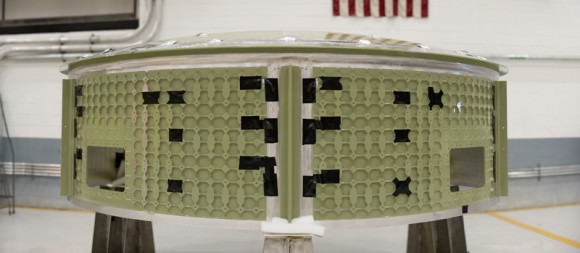
“Most of the work on the parts needed to complete the GTA after completion of the welding is well along. They will be installed inside following a pressure test of the crew cabin that is scheduled for June. These include mass and volume simulators for items like the crew seats and consoles, lockers, waste management etc. On the outside we’ll add simulators for the parachutes, compressed gases, propellants and thrusters all around the shell we welded together”.
“Then we’ll add the simulated [cone shaped] thermal protection system (TPS) aeroshell around that, including a few real TPS tiles. We will also add a heat shield.”
“When we are done adding everything, the final Orion GTA will look very much like a real flight article of the Orion capsule”.
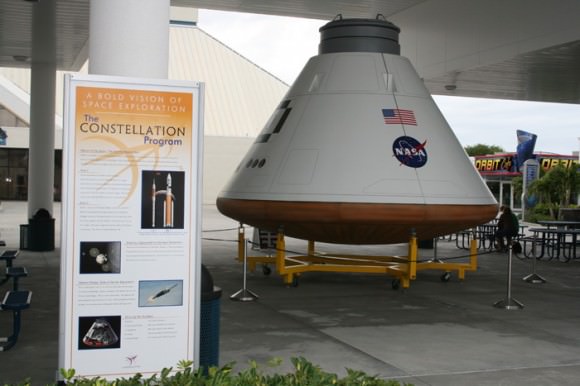
“The GTA will then be placed in a chamber and bombarded with acoustic energy for environmental correlation tests. These tests simulate the flight environment to collect data for the purpose of comparing the results to our predictive models, updating the models, and then refining the design of the crew cabin”.
“We are planning to ship the GTA to our Lockheed facility in Denver around the end of October. It will be integrated with a simulated Launch Abort System to form a launch abort vehicle (LAV) that will subjected to further vibro-acoustic tests next spring. Then the GTA crew module will be shipped to NASA Langley for water drop landing testing to simulate the impact. Those tests will run into 2012”.
“About 86 people are currently working on various aspects of the Orion GTA project at Michoud”, according to Lockheed spokesman Kevin Barre.
The GTA is a key pathfinder vehicle and the first full-sized, flight-like test article for Orion. It will be subjected to numerous stringent tests which are crucial learning exercises that will help validate the cabin design and will be used to incorporate changes to the tools and manufacturing processes that will eventually lead to a human rated production vehicle.
This Orion GTA capsule is an indispensible forerunner to the next generation Orion vehicle which NASA had planned for human flights to shot to the Moon and the International Space Station (ISS). It is not an unmanned “rescue capsule”, or lifeboat, as recently proposed by President Obama at his April 15 space policy speech at the Kennedy Space Center (KSC).
President Obama’s new announcement to resuscitate Orion as a “rescue capsule” was a significant refinement to his original plan of February 2010 to wholly terminate Orion and Project Constellation as part of his initial 2011 NASA Budget proposal which would radically alter the future path of NASA.
Related stories by Ken Kremer

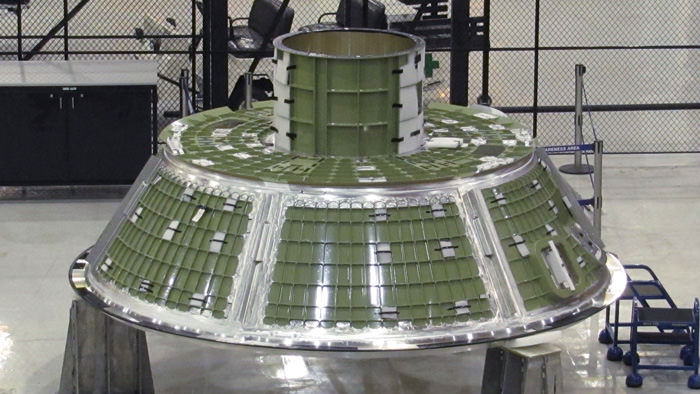
The 4-seater ground test version can’t do anything of that, not even LEO maneuvers besides docking at a guess. Price is sleazily equivocating between the 10 ton capsule and the complete 25 ton craft with the modules for NEO capability. Which craft hasn’t been constructed, apparently have no funding or construction being made, and have no lifter.
This, and the downsized NEO capability of a 4-seater, is why it may make sense to modify a finished capsule to be capable as an ISS rescue vehicle. Preferably upgraded to a 6-seater, to compete with the Dragon 7-seater.
But that upgrading to more seats and at minimum LEO braking means more money down the drain. I wouldn’t do it, and indeed it seems to be a political compromise which sole purpose is to keep Orion believers and other constituents happy.
This is a good analogy. A car tire is designed to be able to drive on roads from Alaska to South America.
It would be a great disappointment to roll out a tire from the garage and try to make it go anywhere. The Orion GTA is the prototype to begin making that tire.
Will this capsule have an easy to swallow coating? 😀
No lifter? What about the existing Delta IV, Atlas V, and the forthcoming Falcon 9?
@Torbjorn Larsson
That’s a good point. Space is, after all, space. Make something to use here in orbit that can handle all the normal hazards wherever it may go in the solar system, and that will save a tremendous amount of engineering in the future.
The problem I have with the Obama plan is it trades in hardware under construction for a fist full of promises. If he made this move a year later they could probably salvaged alot more than just the capsule from constellation.
At this point if Lockheed is to save even that much then they need something functional enough to represent how ready they are to be a component in the new plan.
More than a few other companies want this project stopped immediately because they claim to have competing ideas ready for production.
…but what they have are rough sketches and mockups, not flight ready hardware.
They don’t want to start this new era by competing against a fleshed out vehicle that has years of lead time in development and abilities that go beyond being an ISS taxi.
None of them man-rated yet, I believe.
Btw, the only one capable of lifting 25 ton to LEO among them is the Atlas V HLV (29 ton). (Falcon 9 lifts 10 ton @ LEO.)
I don’t see the connection between my argument or (likely lousy) analogy to your conclusion. So, I’m sorry if I’m raining on your parade, but it behooves me in case it was unclear to point out that my analysis is arguing against designing parts that have no functional fulfillment.
Actually I can generalize that: it is a waste of resources to design for other function than needed. That applies to over-design generalization too; unless a system isn’t naturally general, say a knife, it is a waste of time, money and other resources now and later to take a specialized design, say a ribbon cutter, and generalize it.
This applies to LEO vs NEO crafts. An NEO craft needs more space, supplies, power capability and longevity, delta-v capability and longevity, and a better shielding among other things. It is _very_ costly to design and lift unnecessary weight in this business.
I think Augustine’s basic strategy as implemented by Obama makes some sense here. If you have a heavy-lifter, it can start to lift heavy LEO but also NEO stuff. It has a use from day one, considering the service and building requirements of ISS. Luckily for this strategy, ISS was indeed saved.
After man-rating, it could be something like the original Orion:
My beef is that there is no specific target discussed yet, because the future capabilities aren’t well constrained. This is somewhat putting the cart before the horse, and it certainly wasn’t the Apollo strategy. It also leaves a lot of uncertainty “to retire”, as NASA puts it.
That was supposed to be “better heat shielding” (for the high-speed return trajectory), but it turns out I forgot the need for better thermal, radiation and collision management anyway.
Godspeed!
Oh, who really cares? From the space shuttle back to the 1960’s? Inspiring…..NOT. I’ve been a big supporter of the space program, but like everything else in America these days — lacks vision, has surrendered its will. Perhaps after this “new” craft, we can see NASA explore the wonders of powered air flight!.
This capsule is nothing but a chicken running around with its head chopped off. It’s a continuation of the current budget. Who knows what will happen to this come 1 Oct. Unless they roll it into the Exploration Research & Development part of NASA’s budget, there will be cobwebs forming on it this coming Fall.
TL is correct in stating this isn’t part of man system going outside of Earth’s orbit. That program was known as “Constellation”, which President Obama has axed, and funded $2.5 million over the next two years to break down and get rid of.
Although Obama has hinted now we require some sort of man program, it has yet to be fitted/added into a budget which has already been approved by Congress. So don’t hold your breath. We already know what he says and what is actually done rarely comes to fruition.
There is one hopeful sign for the future, when Obama is no longer in the White House; if you remember this was an item pushed by several Senators; this being the budget for Heavy-Lift and Propulsion Research and Development. The budget for this has increased from where it has been for the past several years. Roughly averaging $580 million for the next four years, and then jumping up to 754 million in 2015.
So just maybe… we can fit some manned items into this.
However, the budget for construction around KSC doesn’t include any money during the next 5 years for a building and launch facility for manned projects; however, they do want to make it pretty and easier to get into…go figure.
In short… I would yawn at most heavy lift & manned projects until there is another individual scribbling in the Oval Office.
Correction, the budget for Constellation’s cancellation is 2.5 BILLION over the next two years. 1.9 Billion in FY2011 and $600 Million in FY 2012.
Problem with Obamas Heavy lift is the working definition for “heavy” starts at 25 tons… roughly what could fit in the back of the shuttle (a 100 ton space construction platform). Its a redevelopment of what some EELV’s already provide, and a waste.
What SpaceX and company are building are systems that run about ten tons. They have a long road ahead.
Going to the moon, mars, or deep space asteroids will require “super heavy” rockets that begin at 100 tons payload… and that is just to push the life support systems.
Pursuing less costly small rockets looks good on paper, but it effectively writes humans out of Obama space plan.
If we’re going to keep them in by some aspect then I’d sooner go with an existing capsule and rocket than a promise we’re going to build something in the future.
The current EELV fleet is not “man-rated” now…at least…not yet. ULA has been tasked to develop an Emergency Detection System, which is a “final significant element necessary for a safe and reliable human rated vehicle.”
http://www.ulalaunch.com/site/pages/News.shtml#/45
Delta IV Heavy can be upgraded to lift more than 25 tones of payload according the ULA site. Lets not forget the forthcoming Falcon 9 Heavy: which can deliver 32,000 kg to LEO
When you talk about weight, you also have to talk about orbiting altitude and actual orbit type; when it gets down to it.
Although not publicly published, each system has a maximum weight for altitude and orbit. The maximum may be what it can get into LEO, but you’ll find it cannot get the same weight into a sun-sync location.